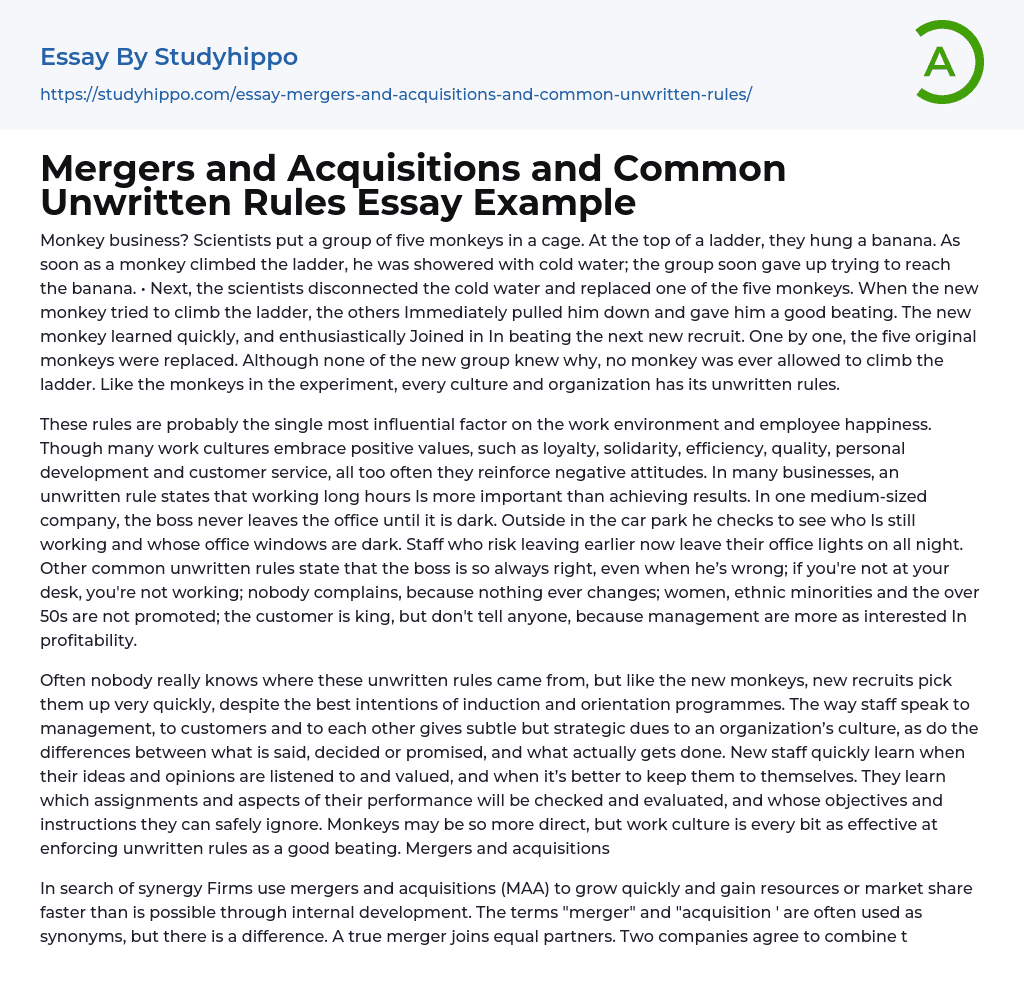

Mergers and Acquisitions and Common Unwritten Rules Essay Example
In an experiment, scientists placed a banana at the top of a ladder in a cage with five monkeys. Whenever a monkey tried to climb the ladder, they were sprayed with cold water, which eventually discouraged all of them from attempting to reach the banana. Later on, one of the original monkeys was replaced with a new one. When the new monkey attempted to climb the ladder, it was immediately pulled down and physically punished by the others. The new monkey quickly learned from this experience and joined in on punishing subsequent new monkeys. Over time, all five of the original monkeys were replaced but none of them understood why climbing the ladder was forbidden.
This experiment illustrates that similar to the monkeys' behavior, unwritten rules exist within every culture and organization.
The work en
...vironment and employee happiness are heavily influenced by these rules, which are likely the most influential factor. While many work cultures embrace positive values like loyalty, solidarity, efficiency, quality, personal development, and customer service, they frequently reinforce negative attitudes. In numerous businesses, an unwritten rule exists that prioritizes working long hours over achieving results. In a medium-sized company, the boss remains in the office until it is dark and checks the car park to see who is still working and whose office windows are dark. To avoid risks, staff members now leave their office lights on all night if they leave earlier. Other common unwritten rules include always considering the boss right, even when they're wrong; equating being at your desk with working; nobody complains because nothing changes; women, ethnic minorities, and people over 50 aren't promoted;
and management is primarily interested in profitability despite claiming that the customer is king.
Despite the introduction and orientation programs, the origins of these unspoken regulations are often unidentified, but new recruits promptly embrace them. The way workers interact with management, customers, and each other subtly mirrors the organization's culture. Understanding the culture is also influenced by inconsistencies between words, decisions, promises, and actual actions. New employees acquire knowledge of which ideas and opinions are valued and when it's preferable to remain quiet. They also discover which tasks and aspects of their job will be evaluated and which goals and instructions can be ignored. Work culture is equally effective in enforcing unspoken rules as physical punishment - this remains true even during mergers and acquisitions.
Mergers and acquisitions (MAA) refer to the process through which companies achieve synergy and accelerate growth. This is done by acquiring resources or market share at a faster rate than internal development allows. While the terms "merger" and "acquisition" are often used interchangeably, they have distinct meanings. A true merger involves merging the operations and assets of two equal partners who agree to merge on fair terms. They give up their respective shares, issue new ones, and establish a new company. Examples like ExxonMobil or (AOL) Time Warner illustrate this concept. On the other hand, an acquisition or takeover takes place when one company aims to gain control over another by obtaining a majority of its shares or assets.
Two types of takeovers, a friendly takeover and a hostile takeover, are distinguished by the price per share offered. A friendly takeover occurs when a bid is
accepted by the target company, while a hostile takeover happens when the bid is rejected. Many companies choose mergers and acquisitions (M;A) to foster growth and achieve synergy. Synergy arises when the value of the newly formed entity exceeds that of its individual components combined. This can be achieved in several ways while keeping costs in check. Firstly, duplicate functions can be eliminated, often resulting in staff reductions. Secondly, merging or taking over another company allows for asset consolidation and generates economies of scale. By becoming larger, better terms and conditions can be negotiated with suppliers. Lastly, combining expertise enables companies to create innovative products or services like Disney's collaboration with Pixar to produce groundbreaking computer-animated films such as Toy Story.
Initially, Disney and Pixar had a cooperative relationship. However, in 2006, Disney acquired Pixar from its owner Steve Jobs. Although partnerships may appear ideal in theory, mergers and acquisitions (M&A) typically entail substantial organizational and structural changes and may not consistently meet investor expectations. There are numerous instances of unsuccessful M&A deals such as the DaimlerChrysler merger. Nevertheless, many company leaders continue to seek favorable opportunities. QUIZ: Is it a balanced merger?
- Money essays
- Financial Accounting essays
- Market Segmentation essays
- Supply And Demand essays
- Purchasing essays
- Forecasting essays
- Legacy essays
- Bank essays
- Corporate Finance essays
- Financial News essays
- Financial Ratios essays
- Financial Services essays
- Free Market essays
- Shareholder essays
- Personal finance essays
- Equity essays
- Financial Crisis essays
- Banking essays
- Credit Card essays
- Currency essays
- Debt essays
- Gold essays
- Loan essays
- Enron Scandal essays
- Foreign Exchange Market essays
- Investment essays
- Venture Capital essays
- Stock Market essays
- Retirement essays
- Donation essays
- Net Present Value essays
- Income Statement essays
- Commercial Bank essays
- Debit Card essays
- Deposit Account essays
- Subprime Lending essays
- Perfect Competition essays
- Underwriting essays
- Synergy essays
- Valuation essays
- Investing essays
- Asset essays
- Depreciation essays
- Discounted Cash Flow essays
- Foreign Direct Investment essays
- Funds essays
- Internal Rate Of Return essays
- Revenue essays
- Day Trading essays
- Futures Trading essays



